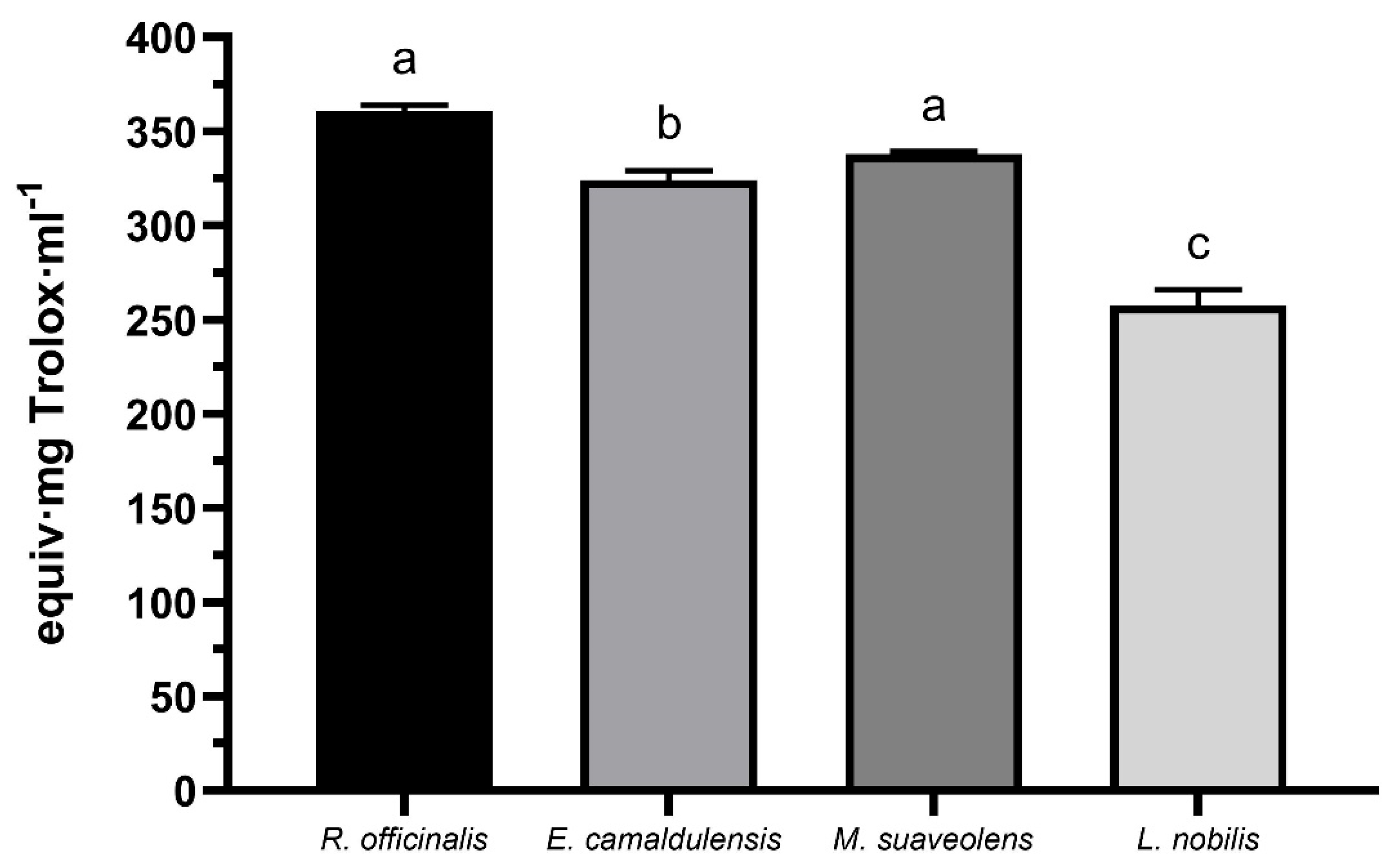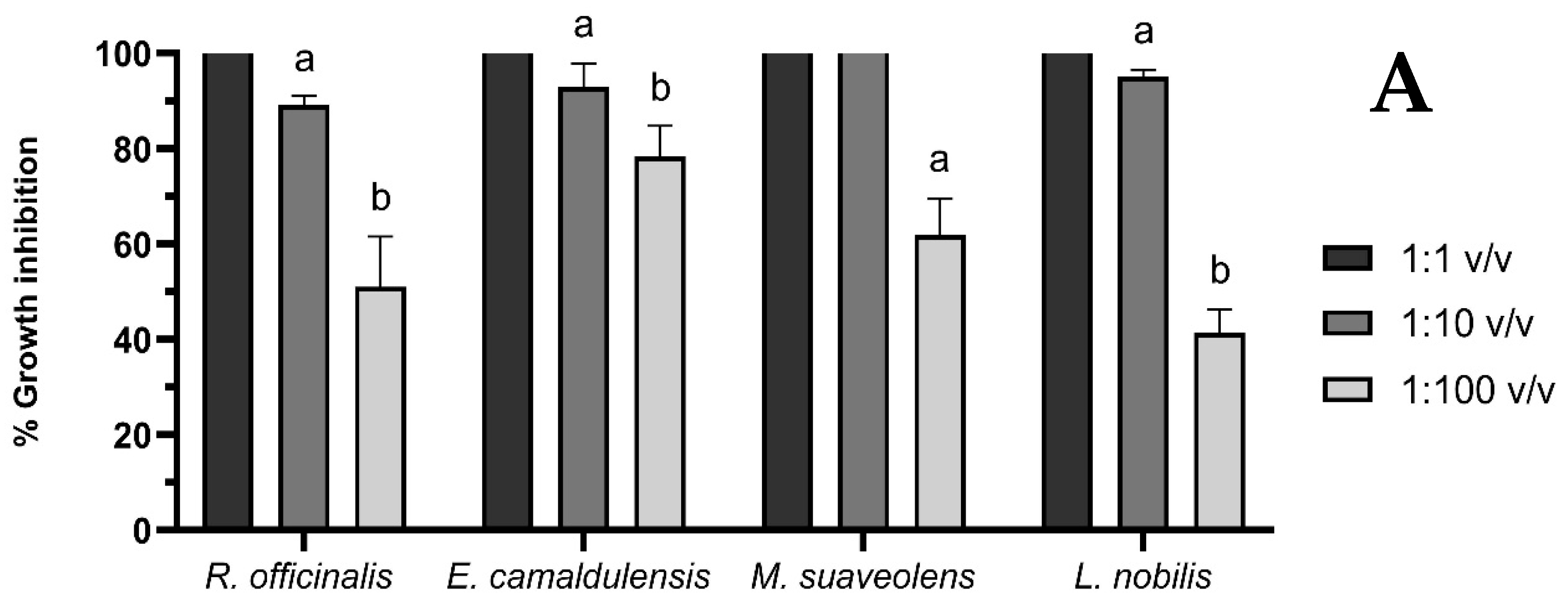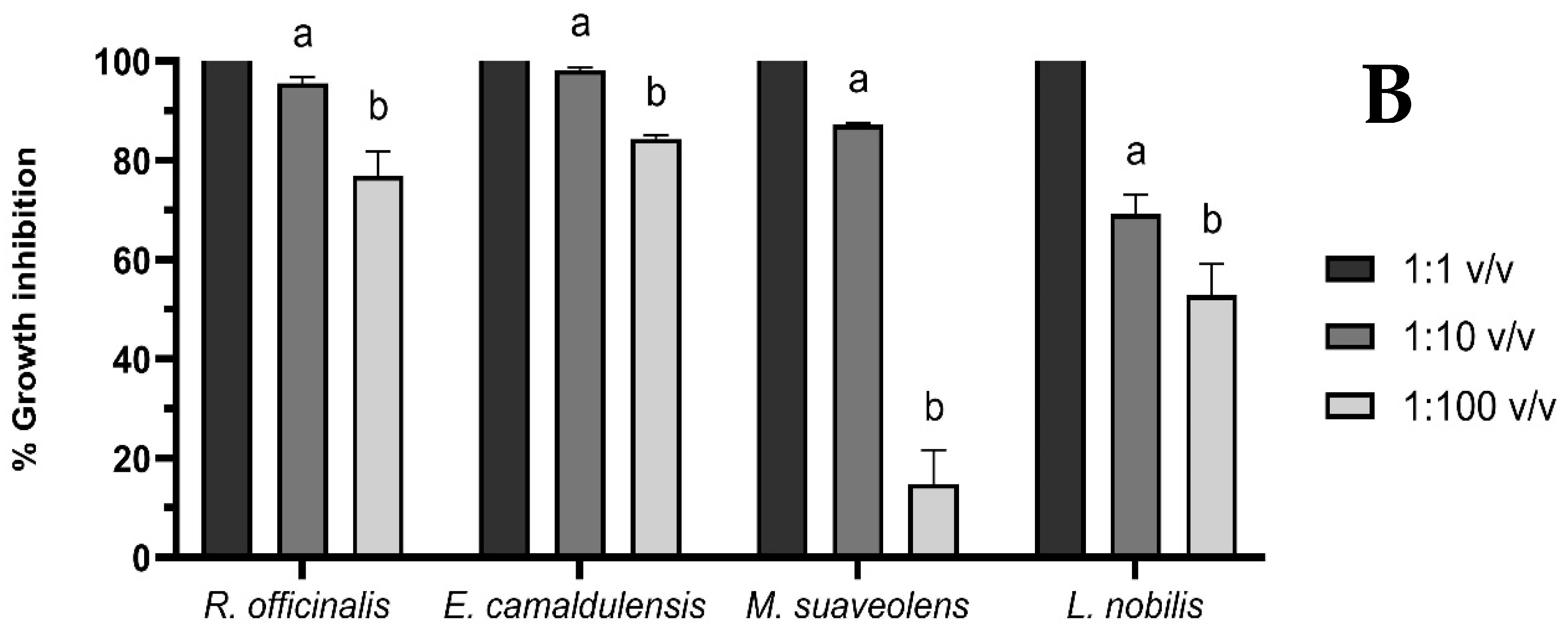Essential Oils as Nature’s Dual Powerhouses for Agroindustry and Medicine: Volatile Composition and Bioactivities—Antioxidant, Antimicrobial, and Cytotoxic
Abstract
1. Introduction
2. Materials and Methods
2.1. Preparation of Raw Material and Essential Oils Extraction
2.2. Analysis of Volatile Compounds by Solid Phase Microextraction—Gas Chromatography–Mass Spectrometry (SPME-GC-MS)
2.2.1. HS-SPME
2.2.2. GC–MS Analysis
2.3. Antibacterial Activity
2.3.1. Broth Microdilution
2.3.2. Agar Diffusion
2.4. Antioxidant Activity
2.5. Antiproliferative Activity
2.6. Statistical Analysis
3. Results and Discussion
3.1. Aromatic Profiles of the Essential Oils
3.2. Evaluation of the Antioxidant Activity of the EOs
3.3. Evaluation of the Antimicrobial Activity of the EOs
3.4. Evaluation of the Cytotoxic Activity of the EOs
4. Conclusions
Author Contributions
Funding
Data Availability Statement
Conflicts of Interest
References
- Bruneton, J. Factores de variabilidad de los aceites esenciales. In Aceites Esenciales; Acribia S.A.: Zaragoza, Spain, 2001. [Google Scholar]
- Adorjan, B.; Buchbauer, G. Biological Properties of Essential Oils: An Updated Review. Flavour Fragr. J. 2010, 25, 407–426. [Google Scholar] [CrossRef]
- Holley, R.A.; Patel, D. Improvement in Shelf-Life and Safety of Perishable Foods by Plant Essential Oils and Smoke Antimicrobials. Food Microbiol. 2005, 22, 273–292. [Google Scholar] [CrossRef]
- Beretta, G.; Artali, R.; Facino, R.M.; Gelmini, F. An Analytical and Theoretical Approach for the Profiling of the Antioxidant Activity of Essential Oils: The Case of Rosmarinus officinalis L. J. Pharm. Biomed. Anal. 2011, 55, 1255–1264. [Google Scholar] [CrossRef]
- Delgado-Adámez, J.; Garrido, M.; Bote, M.E.; Fuentes-Pérez, M.C.; Espino, J.; Martín-Vertedor, D. Chemical Composition and Bioactivity of Essential Oils from Flower and Fruit of Thymbra capitata and Thymus Species. J. Food Sci. Technol. 2017, 54, 1857–1865. [Google Scholar] [CrossRef] [PubMed]
- Salehi, B.; Sharifi-Rad, J.; Quispe, C.; Llaique, H.; Villalobos, M.; Smeriglio, A.; Trombetta, D.; Ezzat, S.M.; Salem, M.A.; Zayed, A.; et al. Insights into Eucalyptus Genus Chemical Constituents, Biological Activities and Health-Promoting Effects. Trends Food Sci. Technol. 2019, 91, 609–624. [Google Scholar] [CrossRef]
- Hudzicki, J. Kirby-Bauer Disk Diffusion Susceptibility Test Protocol. Am. Soc. Microbiol. 2009, 15, 1–23. [Google Scholar]
- Turoli, D.; Testolin, G.; Zanini, R.; Bellù, R. Determination of Oxidative Status in Breast and Formula Milk. Acta Paediatr. 2004, 93, 1569–1574. [Google Scholar] [CrossRef] [PubMed]
- Božovic, M.; Pirolli, A.; Ragno, R. Mentha suaveolens Ehrh. (Lamiaceae) Essential Oil and Its Main Constituent Piperitenone Oxide: Biological Activities and Chemistry. Molecules 2015, 20, 8605–8633. [Google Scholar] [CrossRef]
- Malabadi, R.B.; Kolkar, K.P.; Meti, N.T.; Chalannavar, R.K. Camphor Tree, Cinnamomum camphora (L.); Ethnobotany and Pharmacological Updates. Biomedicine 2021, 41, 181–184. [Google Scholar] [CrossRef]
- Allenspach, M.; Steuer, C. α-Pinene: A Never-Ending Story. Phytochemistry 2021, 190, 112857. [Google Scholar] [CrossRef]
- Zhao, Z.J.; Sun, Y.L.; Ruan, X.F. Bornyl Acetate: A Promising Agent in Phytomedicine for Inflammation and Immune Modulation. Phytomedicine 2023, 114, 154781. [Google Scholar] [CrossRef] [PubMed]
- Jafari-Sales, A.; Pashazadeh, M. Study of Chemical Composition and Antimicrobial Properties of Rosemary (Rosmarinus officinalis) Essential Oil on Staphylococcus aureus and Escherichia coli in Vitro. Int. J. Life Sci. Biotechnol. 2020, 3, 62–69. [Google Scholar] [CrossRef]
- Hcini, K.; Sotomayor, J.A.; Jordan, M.J.; Bouzid, S. Chemical Composition of the Essential Oil of Rosemary (Rosmarinus officinalis L.) of Tunisian Origin. Asian J. Chem. 2013, 25, 2601–2603. [Google Scholar] [CrossRef]
- Mulyaningsih, S.; Sporer, F.; Zimmermann, S.; Reichling, J.; Wink, M. Synergistic Properties of the Terpenoids Aromadendrene and 1,8-Cineole from the Essential Oil of Eucalyptus globulus against Antibiotic-Susceptible and Antibiotic-Resistant Pathogens. Phytomedicine 2010, 17, 1061–1066. [Google Scholar] [CrossRef]
- Taher Maghsoodlou, M.; Kazemipoor, N.; Valizadeh, J.; Falak, M.; Seifi, N.; Rahneshan, N. Essential Oil Composition of Eucalyptus microtheca and Eucalyptus viminalis. Avicenna J. Phytomed. 2015, 5, 540–552. [Google Scholar]
- Pereira, S.I.; Freire, C.S.R.; Neto, C.P.; Silvestre, A.J.D.; Silva, A.M.S. Chemical Composition of the Essential Oil Distilled from the Fruits of Eucalyptus globulus Grown in Portugal. Flavour. Fragr. J. 2005, 20, 407–409. [Google Scholar] [CrossRef]
- Park, S.Y.; Jung, W.J.; Kang, J.S.; Kim, C.M.; Park, G.; Choi, Y.W. Neuroprotective Effects of α-Iso-Cubebene against Glutamate-Induced Damage in the HT22 Hippocampal Neuronal Cell Line. Int. J. Mol. Med. 2015, 35, 525–532. [Google Scholar] [CrossRef]
- Liu, S.; Zhao, Y.; Cui, H.F.; Cao, C.Y.; Zhang, Y.B. 4-Terpineol Exhibits Potent in Vitro and in Vivo Anticancer Effects in Hep-G2 Hepatocellular Carcinoma Cells by Suppressing Cell Migration and Inducing Apoptosis and Sub-G1 Cell Cycle Arrest. J. Buon 2016, 21, 1195–1202. [Google Scholar]
- Su, C.W.; Tighe, S.; Sheha, H.; Cheng, A.M.S.; Tseng, S.C.G. Safety and Efficacy of 4-Terpineol against Microorganisms Associated with Blepharitis and Common Ocular Diseases. BMJ Open Ophthalmol. 2018, 3, e000094. [Google Scholar] [CrossRef]
- Leporini, M.; Bonesi, M.; Loizzo, M.R.; Passalacqua, N.G.; Tundis, R. The Essential Oil of Salvia rosmarinus Spenn. from Italy as a Source of Health-Promoting Compounds: Chemical Profile and Antioxidant and Cholinesterase Inhibitory Activity. Plants 2020, 9, 798. [Google Scholar] [CrossRef]
- Chraibi, M.; Farah, A.; Elamin, O.; Iraqui, H.; Fikri-Benbrahim, K. Characterization, Antioxidant, Antimycobacterial, Antimicrobial Effcts of Moroccan Rosemary Essential Oil, and Its Synergistic Antimicrobial Potential with Carvacrol. J. Adv. Pharm. Technol. Res. 2020, 11, 25–29. [Google Scholar] [CrossRef] [PubMed]
- Ben Hassine, D.; Abderrabba, M.; Yvon, Y.; Lebrihi, A.; Mathieu, F.; Couderc, F.; Bouajila, J. Chemical Composition and in Vitro Evaluation of the Antioxidant and Antimicrobial Activities of Eucalyptus gillii Essential Oil and Extracts. Molecules 2012, 17, 9540–9558. [Google Scholar] [CrossRef] [PubMed]
- Noumi, V.D.; Nguimbou, R.M.; Tsague, M.V.; Deli, M.; Rup-Jacques, S.; Amadou, D.; Baudelaire, E.N.; Sokeng, S.; Njintang, N.Y. Phytochemical Profile and In Vitro Antioxidant Properties of Essential Oils from Powder Fractions of Eucalyptus camaldulensis Leaves. Am. J. Plant Sci. 2021, 12, 329–346. [Google Scholar] [CrossRef]
- Kivrak, Ş.; Göktürk, T.; Kivrak, İ. Assessment of Volatile Oil Composition, Phenolics and Antioxidant Activity of Bay (Laurus nobilis) Leaf and Usage in Cosmetic Applications. Int. J. Second. Metab. 2017, 4, 148–161. [Google Scholar] [CrossRef]
- Guedri, M.M.; Romdhane, M.; Lebrihi, A.; Mathieu, F.; Bouajila, J. Chemical Composition and Antimicrobial and Antioxidant Activities of Tunisian, France and Austrian Laurus nobilis (Lauraceae) Essential Oils. Not. Bot. Horti Agrobot. Cluj Napoca 2020, 48, 1929–1940. [Google Scholar] [CrossRef]
- Bouyahya, A.; Belmehdi, O.; Abrini, J.; Dakka, N.; Bakri, Y. Chemical Composition of Mentha suaveolens and Pinus halepensis Essential Oils and Their Antibacterial and Antioxidant Activities. Asian Pac. J. Trop. Med. 2019, 12, 117–122. [Google Scholar] [CrossRef]
- Al-Mijalli, S.H.; Assaggaf, H.; Qasem, A.; El-Shemi, A.G.; Abdallah, E.M.; Mrabti, H.N.; Bouyahya, A. Antioxidant, Antidiabetic, and Antibacterial Potentials and Chemical Composition of Salvia officinalis and Mentha suaveolens Grown Wild in Morocco. Adv. Pharmacol. Pharm. Sci. 2022, 2022, 2844880. [Google Scholar] [CrossRef]
- Bajalan, I.; Rouzbahani, R.; Pirbalouti, A.G.; Maggi, F. Antioxidant and Antibacterial Activities of the Essential Oils Obtained from Seven Iranian Populations of Rosmarinus officinalis. Ind. Crop. Prod. 2017, 107, 305–311. [Google Scholar] [CrossRef]
- Zaouali, Y.; Bouzaine, T.; Boussaid, M. Essential Oils Composition in Two Rosmarinus officinalis L. Varieties and Incidence for Antimicrobial and Antioxidant Activities. Food Chem. Toxicol. 2010, 48, 3144–3152. [Google Scholar] [CrossRef]
- Santos, P.A.S.R.; Avanço, G.B.; Nerilo, S.B.; Marcelino, R.I.A.; Janeiro, V.; Valadares, M.C.; Machinski, M. Assessment of Cytotoxic Activity of Rosemary (Rosmarinus officinalis L.), Turmeric (Curcuma longa L.), and Ginger (Zingiber officinale R.) Essential Oils in Cervical Cancer Cells (HeLa). Sci. World J. 2016, 2016, 9273078. [Google Scholar] [CrossRef]
- Wang, W.; Li, N.; Luo, M.; Zu, Y.; Efferth, T. Antibacterial Activity and Anticancer Activity of Rosmarinus officinalis L. Essential Oil Compared to That of Its Main Components. Molecules 2012, 17, 2704–2713. [Google Scholar] [CrossRef] [PubMed]
- Eid, A.M.; Jaradat, N.; Issa, L.; Abu-Hasan, A.; Salah, N.; Dalal, M.; Mousa, A.; Zarour, A. Evaluation of Anticancer, Antimicrobial, and Antioxidant Activities of Rosemary (Rosmarinus officinalis) Essential Oil and Its Nanoemulgel. Eur. J. Integr. Med. 2022, 55, 102175. [Google Scholar] [CrossRef]
- Abiri, R.; Atabaki, N.; Sanusi, R.; Malik, S.; Abiri, R.; Safa, P.; Shukor, N.A.A.; Abdul-Hamid, H. New Insights into the Biological Properties of Eucalyptus-Derived Essential Oil: A Promising Green Anti-Cancer Drug. Food Rev. Int. 2022, 38, 598–633. [Google Scholar] [CrossRef]
- Sobral, M.V.; Xavier, A.L.; Lima, T.C.; De Sousa, D.P. Antitumor Activity of Monoterpenes Found in Essential Oils. Sci. World J. 2014, 2014, 953451. [Google Scholar] [CrossRef]
- Pauzer, M.S.; Borsato, T.D.O.; de Almeida, V.P.; Raman, V.; Justus, B.; Pereira, C.B.; Flores, T.B.; Maia, B.H.L.N.S.; Meneghetti, E.K.; Kanunfre, C.C.; et al. Eucalyptus cinerea: Microscopic Profile, Chemical Composition of Essential Oil and Its Antioxidant, Microbiological and Cytotoxic Activities. Braz. Arch. Biol. Technol. 2021, 64, e21200772. [Google Scholar] [CrossRef]
- Brahmi, F.; Hadj-Ahmed, S.; Zarrouk, A.; Bezine, M.; Nury, T.; Madani, K.; Chibane, M.; Vejux, A.; Andreoletti, P.; Boulekbache-Makhlouf, L.; et al. Evidence of Biological Activity of Mentha Species Extracts on Apoptotic and Autophagic Targets on Murine RAW264.7 and Human U937 Monocytic Cells. Pharm. Biol. 2017, 55, 286–293. [Google Scholar] [CrossRef]
- Spagnoletti, A.; Guerrini, A.; Tacchini, M.; Vinciguerra, V.; Leone, C.; Maresca, I.; Simonetti, G.; Sacchetti, G.; Angiolella, L. Chemical Composition and Bio-Efficacy of Essential Oils from Italian Aromatic Plants: Mentha suaveolens, Coridothymus capitatus, Origanum hirtum and Rosmarinus officinalis. Nat. Prod. Commun. 2016, 11, 1517–1520. [Google Scholar] [CrossRef] [PubMed]
- Stringaro, A.; Colone, M.; Angiolella, L. Antioxidant, Antifungal, Antibiofilm, and Cytotoxic Activities of Mentha spp. Essential Oils. Medicines 2018, 5, 112. [Google Scholar] [CrossRef]
- Nagah, N.; Mostafa, I.; Dora, G.; El-Sayed, Z.; Ateya, A.M. Essential Oil Composition, Cytotoxicity against Hepatocellular Carcinoma, and Macro and Micro-Morphological Fingerprint of Laurus nobilis Cultivated in Egypt. Egypt. J. Bot. 2021, 61, 521–540. [Google Scholar] [CrossRef]




| Compounds | S. rosmarinus | E. camaldulensis | M. suaveolens | L. nobilis |
|---|---|---|---|---|
| Eucalyptol | 20.77 | 27.91 | - | 33.36 |
| Camphor | 14.80 | - | - | - |
| α-Pinene | 13.18 | 5.29 | - | 1.06 |
| L-bornyl acetate | 10.66 | - | - | - |
| cis-Verbenone | 5.06 | - | - | - |
| β-Pinene | 4.52 | - | - | - |
| Borneol | 4.23 | - | - | - |
| Camphene | 4.09 | - | - | - |
| L-β-pinene | 3.25 | - | - | 1.23 |
| γ-Terpinene | 2.74 | - | - | - |
| α-Terpinolen | 2.66 | - | - | - |
| p-Menth-1-en-8-ol | 2.37 | 7.53 | - | 2.93 |
| 4-Terpineol | 1.75 | 2.49 | 8.69 | 3.65 |
| Linalol | 1.55 | - | - | 17.29 |
| 3-Pinanone | 1.37 | - | - | - |
| α-Fellandrene | 1.30 | - | - | - |
| p-Mentha-1,4(8)-diene- | 1.22 | - | - | - |
| m-cymene | 1.19 | - | - | - |
| L-alloaromadendrene | - | 13.49 | - | - |
| (+)-Ledene | - | 9.69 | 1.30 | - |
| B-Caryophyllene oxide | - | 8.58 | - | - |
| α-Gurjunene | - | 7.47 | - | - |
| D-Limonene | - | 3.87 | - | - |
| 1-Methyl-1-(4-methylphenyl) ethyl phenylcarbamate | - | 2.74 | - | - |
| Epiglobulol | - | 2.01 | - | - |
| Piperitone oxide | - | - | 55.73 | - |
| β-Cubebene | - | - | 15.83 | - |
| L-Caryophyllene | - | - | 6.73 | - |
| 4-Terpinenyl acetate | - | - | 5.32 | - |
| α-Terpineol acetate | - | - | - | 24.32 |
| Eugenol | - | - | - | 6.13 |
| Sabinene | - | - | - | 2.88 |
| Pseudolimonen | - | - | - | 1.28 |
| Essential Oil | E. coli | L. innocua |
|---|---|---|
| Ampicillin | 29.00 ± 1.40 a | 34.50 ± 2.10 a |
| R. officinalis | 15.80 ± 1.83 cd | 17.50 ± 1.41 b |
| E. camaldulensis | 8.75 ± 0.35 b | 15.50 ± 0.70 b |
| M. suaveolens | 12.50 ± 1.41 bd | 9.12 ± 0.88 c |
| L. nobilis | 19.50 ± 2.12 c | 14.25 ± 0.35 b |
Disclaimer/Publisher’s Note: The statements, opinions and data contained in all publications are solely those of the individual author(s) and contributor(s) and not of MDPI and/or the editor(s). MDPI and/or the editor(s) disclaim responsibility for any injury to people or property resulting from any ideas, methods, instructions or products referred to in the content. |
© 2025 by the authors. Licensee MDPI, Basel, Switzerland. This article is an open access article distributed under the terms and conditions of the Creative Commons Attribution (CC BY) license (https://creativecommons.org/licenses/by/4.0/).
Share and Cite
Rocha-Pimienta, J.; Espino, J.; Martillanes, S.; Delgado-Adámez, J. Essential Oils as Nature’s Dual Powerhouses for Agroindustry and Medicine: Volatile Composition and Bioactivities—Antioxidant, Antimicrobial, and Cytotoxic. Separations 2025, 12, 145. https://doi.org/10.3390/separations12060145
Rocha-Pimienta J, Espino J, Martillanes S, Delgado-Adámez J. Essential Oils as Nature’s Dual Powerhouses for Agroindustry and Medicine: Volatile Composition and Bioactivities—Antioxidant, Antimicrobial, and Cytotoxic. Separations. 2025; 12(6):145. https://doi.org/10.3390/separations12060145
Chicago/Turabian StyleRocha-Pimienta, Javier, Javier Espino, Sara Martillanes, and Jonathan Delgado-Adámez. 2025. "Essential Oils as Nature’s Dual Powerhouses for Agroindustry and Medicine: Volatile Composition and Bioactivities—Antioxidant, Antimicrobial, and Cytotoxic" Separations 12, no. 6: 145. https://doi.org/10.3390/separations12060145
APA StyleRocha-Pimienta, J., Espino, J., Martillanes, S., & Delgado-Adámez, J. (2025). Essential Oils as Nature’s Dual Powerhouses for Agroindustry and Medicine: Volatile Composition and Bioactivities—Antioxidant, Antimicrobial, and Cytotoxic. Separations, 12(6), 145. https://doi.org/10.3390/separations12060145







